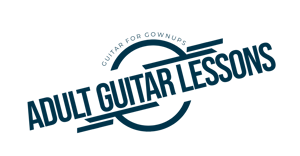When first getting started on learning how to play guitar one of the first things you will want to is learn the guitar notes.
In the beginning this can seem a little overwhelming. On a guitar with 22 frets, each fret contains 6 individual notes, for a total of 132 notes.
That’s a lot to learn for a new guitar player!
Here are some things you can do to make learning the guitar notes easier.
1. First learn the names of the open strings
A guitar in standard “E” tuning is tuned to the notes”
E A D G B E
2. Learn how the strings are “numbered”
Guitar strings are often referred to as a number. String number “1” is the high E string, or the “skinniest” string that is “at the bottom” as you are holding the guitar.
The other string numbers fall into place sequentially as follows:
1st string – E (high)
2nd string – B
3rd string – G
4th string – D
5th string – A
6th string – E (low)
Learning the string “numbers” is an important step in the process of learning the guitar notes.
3. Learn how to number the “frets”
When referring to various note positions on the guitar, in addition to string numbers, fret are also given a numerical value.
This one is easy. Just start on the lowest fret on the guitar (closest to the headstock) and start with “one”. Simply count up from there sequentially until you run out of frets.
4. Brush up on some theory
Music notes are easy to understand when you break them down. There are really only 12 tonal possibilities. First, let’s look at the notes in the C major scale.
C D E F G A B C
These are the whole notes, and in between these notes are notes that are called “sharp” or “flat” – with the exception of the notes E & F, and B & C.
So all the note possibilities would be as follows:
C, C#(Db), D, D#(Eb), E, F, F#(Gb), G, G#(Ab), A, A#(Bb), B, C
That makes only 12 notes to learn!
4. Learn the notes on the 6th string
When forming chords and determining scales, instead of trying to memorize all the notes on the fret board, an easier solution is to just learn the notes on the 6th string to begin with.
This is because the “root” note of many chords and scales can be found on the 6th string.
Learning the notes on the 6th string is made easier by just focusing on learning the whole note locations. You can use the points above as a reference for locating them as follows:
Open string = E
1st Fret = F
3rd Fret = G
5th Fret = A
7th Fret = B
8th Fret = C
10th Fret = D
12th Fret = E (octave)
These are fairly easy to memorize, and noting the location of the fret markers or fret dots will greatly assist in this process.
Once you are familiar with these note positions then locating an “in between note” that is a sharp or flat is pretty easy.
5. Learn the notes on the 5th string
There are also many chords that find their root note on the 5th string, where the 6th string is not included in the chord.
You will encounter this when playing barre chords in the “D” shape.
So to prepare for this, learn the notes on the 5th string, using the same procedure as outlined above in # 4.
6. Learn the “octaves”
Obviously, with over 130 possible note locations, but only 12 actual notes, there are a number of places on the guitar fret board where notes are repeated.
When you start on one note, and play upwards or downwards, and wind up on that same note name again, you have encountered an “octave”.
Once you learn to locate the notes on the 6th and 5th strings, you can then locate the octave for those notes on the other guitar strings.
This makes locating any note on the guitar much easier without the stress of trying to memorize each and every note location on the neck.
To Recap
The thought of having to learn the guitar notes may seem a bit daunting in the beginning, but by taking some time to work on these few shortcuts you will know your way around the guitar neck in no time!



